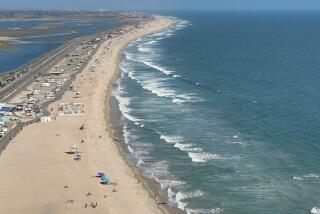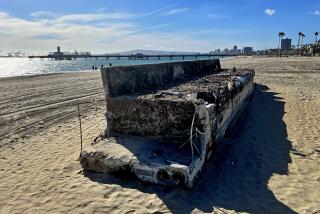Rocks, Reefs Among Protection Plans
- Share via
LONG BRANCH, N.J. — From low-tech rock piles to experimental artificial reefs, East Coast towns trying to preserve their seashores can choose among many beach-protection technologies.
Older solutions that “armored” beaches have lost favor to newer, “soft” solutions, while high-tech strategies remain unproven, experts in coastal erosion say.
“Everybody is marketing their particular structure, rather than taking a particular problem and trying to solve it,” said Paden Woodruff of the Florida Natural Resources Department.
The most common “hard,” or armoring, solutions dot New Jersey’s coast: decades-old groins (boulder piles stretching out into the surf) and stone seawalls, steel bulkheads and sloped rock revetments dividing towns from beaches.
“The rest of the country uses New Jersey as an example of what’s wrong,” said Orrin Pilkey, director of the Program for the Study of Developed Shorelines at Duke University.
Groins, designed to trap sand drifting along the coast, worsen erosion in some areas, at best accumulating sand on one side by starving the other.
Seawalls and bulkheads today are considered so destructive that Maine, North Carolina and South Carolina prohibit new ones. Massachusetts and Florida generally allow new ones only to fill gaps in stretches of seawall; South Carolina won’t let any destroyed ones be rebuilt.
The unyielding surface increases the sea’s churning as waves strike, scouring the beach below and eroding adjacent areas. Seawalls can destroy beaches in as little as two years, but within 30 years on average, Pilkey said.
“Soft solutions” include beach nourishment and dune-building, widening beaches with sand dredged offshore, then piling up dunes and planting them.
The federal government encourages beach “engineering,” figuring that it will reduce future storm damage, but there is intense debate over how long the replenished sand lasts.
The Army Corps of Engineers began doing small-scale coastal-erosion projects in 1824, said Joan Pope of the corps’ Coastal Engineering Research Center in Vicksburg, Miss.
The corps now does large, federally funded beach-widening projects and is experimenting with offshore berms--piling up huge sandbars of dredge that is not beach-quality sand.
“The idea is . . . put it near the shore to let waves rework it and gradually push it toward shore,” Pope said.
Meanwhile, entrepreneurs have created an industry around beach-protection technology.
Several companies market different artificial reefs designed to absorb wave energy and slow erosion--submerged or emergent breakwaters, long concrete blocks or mounds of cemented rubble, rectangular or peaked ones.
Some makers contend that their product traps sand in receding waves and pushes it back toward the beach. But they have dropped claims that artificial reefs actually widen beaches.
Environmental regulators say the jury is still out on the reefs, but suspect that they steal sand from elsewhere. One installed in 1985 in Palm Beach County, Fla., has shifted on the ocean floor. The state is fighting to have it removed.
Woodruff said Florida’s Natural Resources Department is letting Palm Beach install a bigger, better, second-generation reef and will spend $660,000 to monitor it for three years.
Then there are beach de-watering systems. Piping runs under the beach, sucking out 500 gallons of water or more per minute, which lowers the water table so incoming waves drain down through the beach, depositing sand.
Woodruff said the idea has merit.
An experimental system installed at upscale Sailfish Point, Fla., appears to have widened that beach, but he is unsure whether it robbed adjacent beaches. Installation and maintenance over 20 years costs an estimated $2.4 million per mile, roughly one-fourth of what beach replenishment costs.
“There’s no one form of shore protection that works everywhere,” Pope said. “And there’s some areas where nothing will work.”
More to Read
Sign up for Essential California
The most important California stories and recommendations in your inbox every morning.
You may occasionally receive promotional content from the Los Angeles Times.













